Due to wanting to check a statistic that I had seen in a report, I thought I would do my own calculation because the number seemed wrong. As a result, I can report that the total views of the Centre’s blog since its start in late 2015 are now approaching half a million. So thanks very much to everyone who has viewed it and even more to those of you who are regular viewers, we appreciate your company!
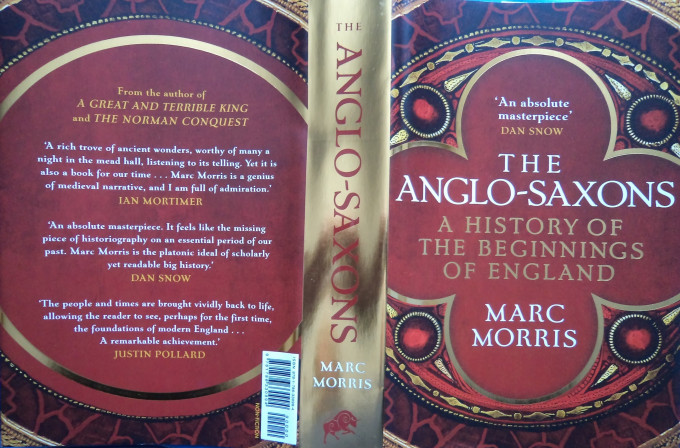
I thought I would start with some news relating to events coming up fairly soon. The first on Tuesday 25 May at 7pm is an ‘In conversation’ with Dr Marc Morris. This will be online using Teams Live Event jointly organized by the Centre, the CCCU Bookshop and the publisher to mark the publication of Marc’s new book, The Anglo-Saxons. A History of The Beginnings of England. The public event is free and booking is not required, just use the joining link which you will find at: https://www.canterbury.ac.uk/events/in-conversation.aspx If you are not used to Teams Live Events, it is worth trying the link beforehand to make sure you can attend. Any issues, please contact the CCCU IT helpdesk on 01227 922626 (weekday office hours only).
Marc is a well-known presenter of history programmes on radio and tv, and has published several acclaimed books including on the Norman Conquest and two biographies – of King John and Edward I. Thus, I am sure this will be a fascinating exploration of the historian’s art as Marc discusses a period that is still often only dimly understood and which encompasses the lives of famous characters such as Theodore of Canterbury, Offa of Mercia, and Alfred of Wessex.
Then the following Tuesday 1 June at 6.30pm, Dr Diane Heath will give her presentation on ‘Medieval Animals: teaching green heritage to support SEND children’s emotional engagement’ as part of the Faculty of Arts, Humanities and Education’s Open Lecture series. Please note this is a week later than first scheduled and if you want to attend this online, free talk, please follow this link to book: https://www.canterbury.ac.uk/arts-humanities-and-education/events/2021/public-lecture-series-2021.aspx
Turning to current matters, I would first like to congratulate Diane for submitting her HLF application earlier this week for her ‘Medieval Animals Heritage’ project – brilliant news! Furthermore, as part of National Gardening Week, my Co-Director Dr Claire Bartram has launched a small project on Kent’s lost gardens, starting with a reissue of her piece in the Canterbury Heritage A–Z (published by the Centre in 2020), please see @BookcultureCCCU for this.
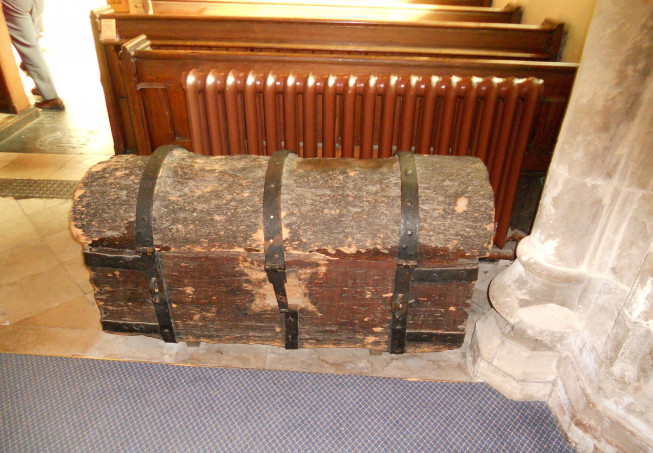
Diane and I have been continuing to work with second-year undergraduates on Claire’s Applied Humanities module. Beth has now produced six draft designs for the information banners relating to the medieval history of St Dunstan’s church, while Ben has been working with Diane concerning the worksheet for schools on how to design a Becket ‘giant’, which if all goes to plan will be joining ‘Eleanor’ and ‘Henry’ for the Medieval Pageant as part of this year’s Canterbury Festival in October. Claire, as the Centre and CCCU’s representative on the Pageant committee, has been working with Dr Chris Pallant in CCCU’s Creative Industries on the second aspect of this giant-making project, as well as similarly coordinating the second part of the ‘Animated Becket’ project that again involves schoolchildren and college or university students. For in addition to Beth and Ben, Michael the MEMS MA student is making excellent progress towards producing a set of materials for schools on ‘Animated Becket’, including students’ worksheets, glossaries and biographies of the main players and teachers’ information sheets and ‘hints and suggestions’ for lesson planning. This is all very exciting and fits well with Diane’s previous work with local schools and her proposed funded ‘Medieval Animals’ project.
It is interesting how connections develop. Having met Max Barrett when Alex Durham and he were filming Paul Bennett’s ‘Early Tudor Canterbury’ for Tudors and Stuarts 2021, I was delighted to be interviewed by him last Sunday for his BBC Radio Kent ‘A – Z of Kent series’. He had reached ‘T’ and decided to make this ‘Tudor Canterbury’, so we spent a very enjoyable time on this topic. I believe it will be on air on a Friday evening in the next few weeks and if anyone finds it interesting, please do let me know.
Something that has also grown out of earlier contacts is a meeting Diane and I will be attending on Friday as part of the Magna Carta Advisory Group to Faversham Town Council on their proposed new exhibition on Magna Carta and the town’s other charters, custumal and civic artefacts. As well as several councillors and the town clerk, we will be joining Sarah Stanley from the Kent Archives and Library Service and Dr Justin Croft, a well-known rare books specialist whose doctoral thesis was on the custumals of the Cinque Ports in the Middle Ages. This is an exciting project that builds on the Centre’s involvement in the 2015 Magna Carta exhibition and the ‘Medieval Faversham’ exhibition three years later.
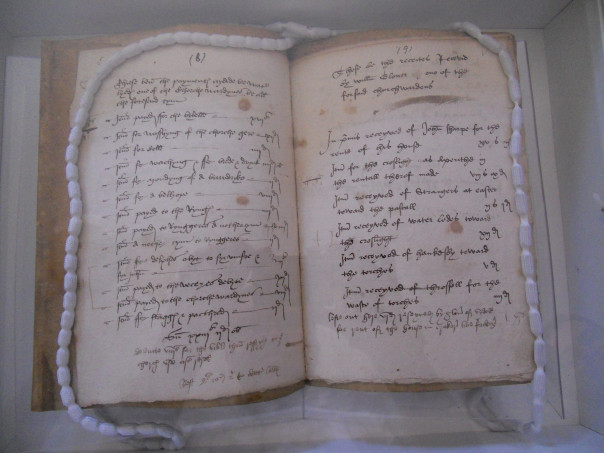
I was also involved with another organization on Monday. For as trustees of the Agricultural Museum Brook, Dr John Bulaitis and I attended a trustees’ meeting and among the items on the agenda was the possibility of applying for a HLF grant to make the museum more inclusive, accessible and relevant as a way to enhance the visitor experience. Although at a very early stage, I am joining a small sub-committee to explore ideas with a well-respected museums’ consultant. This is potentially very exciting, as is my involvement in The Delf Trust at Sandwich where the trustees, too, are exploring applying to the HLF for a small project grant as a starter.
An ambitious project with a different funding stream, the Lossenham Project held another online History Group workshop this week on Tuesday 27 April. This time it was the wills group which was leading the workshop, and all of the eight other members were present in addition to a good number of people interested in the topic. What I wanted to do this time was showcase what the group has been doing, explain our pilot study, suggest where we are going next and see if there is anyone else out there who would like to get involved. To that end I started by going through briefly who made wills in the medieval and early modern periods, for will-making across society increased over the 15th and 16th centuries, and depending on the parish, in some cases labourers were making wills in the early Tudor period.
The next point was to indicate where such sources can be found. Although proving wills was not quite an ecclesiastical monopoly, the Church courts certainly handled most of these cases, and for the parishes of interest to the project this means the diocesan courts of Canterbury and Chichester – archdeaconry and consistory courts, while for those of greater wealth and more extensive landholdings geographically, the wills of the Prerogative Court of Canterbury need to be included. Indeed, at the moment these are the only primary sources the group can access through TNA website, but the hope is to get into the diocesan archives in the relatively near future. However, for the time being we have more than enough wills!
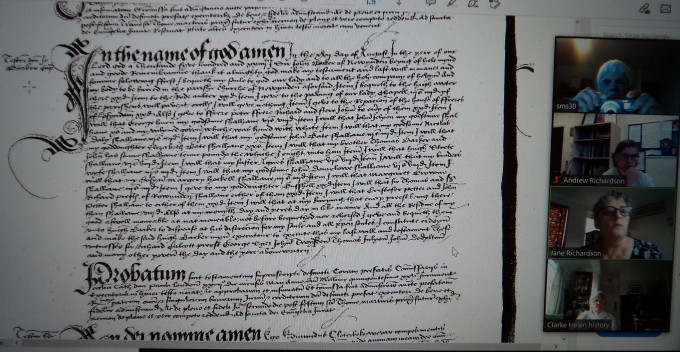
To give people new to such sources an idea of what these wills look like, I took the opportunity to share an early 16th-century widow’s will from Northiam. I had selected this one for several reasons. It is in Latin and I wanted to demonstrate that with some palaeographical skills and basic Latin, especially with Gooder’s Latin for Local History to hand, such documents are a challenge but not impossible. So I went through the will showing how some of it is formulaic and that once you understand this, you can work out these bequests and then concentrate on the more unusual or detailed ones. Thus in Agnes White’s case she wanted to give money to the shrine of St Richard of Chichester and in her home church of Northiam she gave the considerable sum of 6s8d towards painting the rood loft. She is also interesting in her gifts of household items, not only the items themselves, including three chests and a cupboard, but that these were listed in English as well as in Latin. This will also provided information about her three daughters, two of whom were married, and her sons-in-law were her executors.
As always, going through the will had taken longer than I had planned so I just very briefly showed a second, which unfortunately Annie had planned to show later on, but we both agreed that it was interesting for the bequest of a half share in a ship called the Mawdelyn and that Margaret, Oliver Trodys’ widow was to have a parlour and chamber in his house during her widowhood, thereby shedding light on how single parents might be accommodated in at least middle if not old age. Moreover, using these two examples, I drew out the types of research questions that might be explored, for example piety and charity, inheritance practices and contemporary perceptions concerning personal and household items.
Having introduced the people in our wills group to the audience, I handed over the mic to Jane Richardson who explored the will of a Newenden priest whose bequests included money to Lossenham Priory and gifts to three named friars. This clerical dimension is important because it offers ways of exploring networks among the clergy that often cross from religious houses to parish clergy, as well as often involving chantry and other stipendiary priests. Jane and Jason are working on the Newenden wills regarding adding the information from them to the group’s spreadsheet as part of our pilot study. For at our next meeting each pair will have added a sample of wills and we will then be in a better position to decide if things just need tweaking or whether a more radical rethink is required.
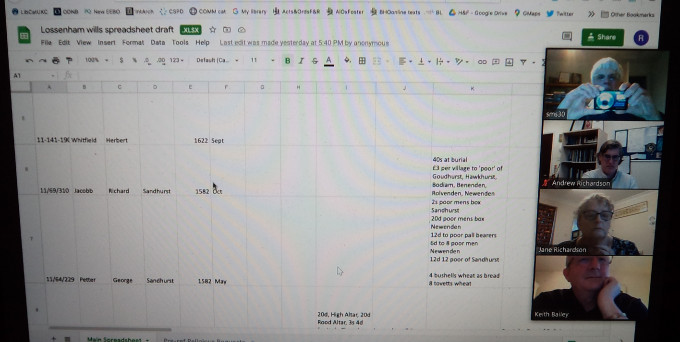
Dr Rebecca Warren next took up the baton to explain the thinking behind how the spreadsheet has been constructed. For example, there are columns for the essential but basic information such as reference, name, parish, will date, probate date, and then columns for parents, family, others named, matters relating to land, household goods etc. There are also places to record an estimate of wealth, named occupation, but also likely occupation based on the will contents, that is in all columns covering seven or so themes, as well as one column that the group feels is very important – for researchers, what topics might this will be useful for. She also pointed out that for the pre-Reformation wills there is a subsidiary spreadsheet in order to record pious and other religious bequests. As Rebecca explained very clearly, how and why these decisions have been made is important because within the group there are people interested in a variety of themes, which means we need to capture the information for these in the spreadsheet, but others may want to use the wills too and we are therefore in some ways trying to second guess what information others might want, and equally to note which wills might be especially valuable for such a study. Thus, this final column is a vital addition.
With all of this in mind, I invited comments and questions from others in the meeting and we had a fruitful discussion about the potential aims of the project, its duration and how knowledge gained might be disseminated. Rebecca’s idea of an annual conference met with considerable support, as well as the possibility of having more extensive articles on the website as a way of keeping the interest and enthusiasm of the volunteers and the wider community. All of this points to the workshop having been successful, although I’m still hoping for some more volunteers.

This week also marks the Thomas Becket: Life, Death and Legacy online conference and I spent a large part of Wednesday morning chairing an excellent session on ‘Breaking new ground: New Archaeological Discoveries at Canterbury Cathedral’. I don’t have the space to cover the three presentations but if you are interested in Professor Paul Bennett’s assessment of Becket’s Canterbury, please see his 2020 Becket Lecture: https://blogs.canterbury.ac.uk/kenthistory/canterbury-tonbridge-and-newenden-what-riches/
Paul was followed by Dr John Crook, who discussed briefly the evolution of saints’ shrines and their architectural settings, before turning to the particular arrangements that were made for preserving and providing pilgrim access to the mortal remains of Thomas Becket. He then focused on the Corona chapel, although, as he said, the loss of the medieval floor hampers any analysis of its original form. He also evaluated the evidence for the form of Becket’s high shrine, dedicated in 1220.
The final presentation in this panel was given by Nathalie Cohen, the cathedral archaeologist, who examined the built heritage of the Eastern Crypt, the original resting place of Thomas Becket prior to his translation to the Trinity Chapel above. Looking at the history of this space over time, from its initial construction to its present-day use, she assessed various previous investigations by antiquarians and scholars, including the late Victorian excavations into the floor of the structure during the winter of 1888, and the subsequent interventions in the same area in the late 1940s. She also noted the evidence that can be provided by archaeological surveys of the architecture, especially the recent survey of graffiti and inscriptions.
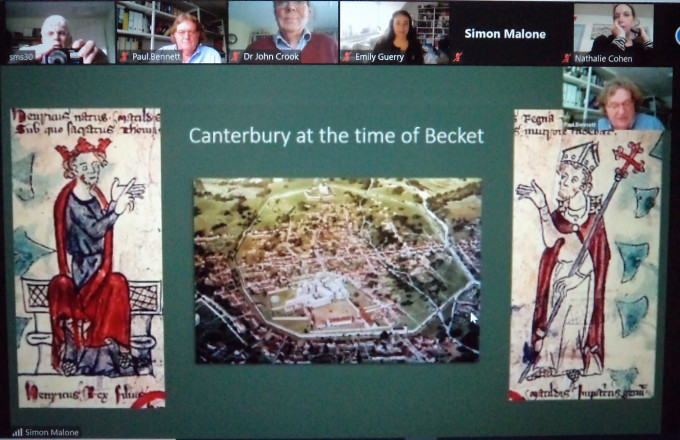
All three presentations generated some interesting questions from our audience, who had obviously enjoyed the session and it meant the conference got off to a brilliant start. Moreover, the day was rounded off by a fascinating keynote lecture by Dr Rachel Koopmans, who used the idea of the year after, that is 1171, to explore the themes of lockdown, stasis and uncertainty, threats and intimidation, and hope through liquid in a phial. It was a fantastic idea and beautifully delivered with great clarity and insight into this turbulent year which is often overlooked.
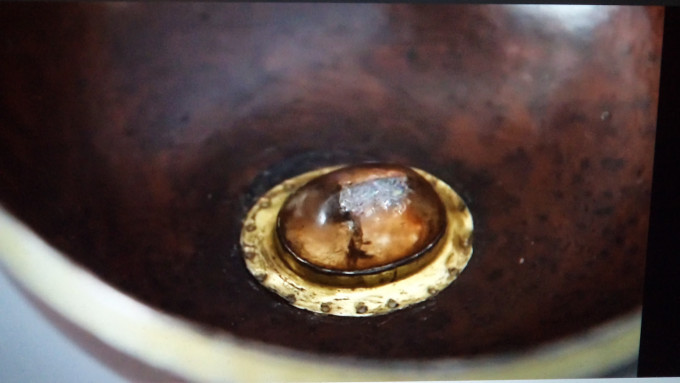
I thought I would also bring you a certain mazer bowl, even though it does not get its premier until tomorrow (Thursday) lunch time, because I have plenty of copy for next week already. My presentation explores what we know about this mazer and similar objects from Canterbury to see whether it may be a Becket relic. As a ‘work in progress’, I examine where and how such objects were used in the Middle Ages, what may have happened during the Reformation, and its later history, including how it came to reside in the Cathedral Treasury.
Now finally, I thought I would remind you that it is Professor Carolyn Oulton’s Kent Maps symposium on Wednesday 5 May and even though I shall be missing the morning sessions – it is the Kent History Postgraduates group meeting, I hope to be there later in the day. The event is free but you need to register at: https://www.eventbrite.co.uk/e/kent-maps-digital-symposium-2021-tickets-146482128991?aff=erelexpmlt
 Centre for Kent History and Heritage
Centre for Kent History and Heritage Sheila Sweetinburgh
Sheila Sweetinburgh 1807
1807

